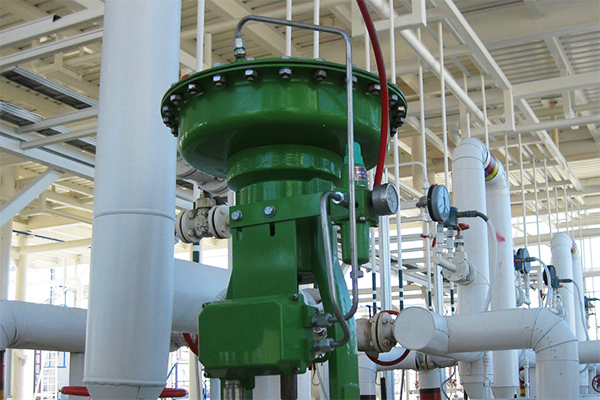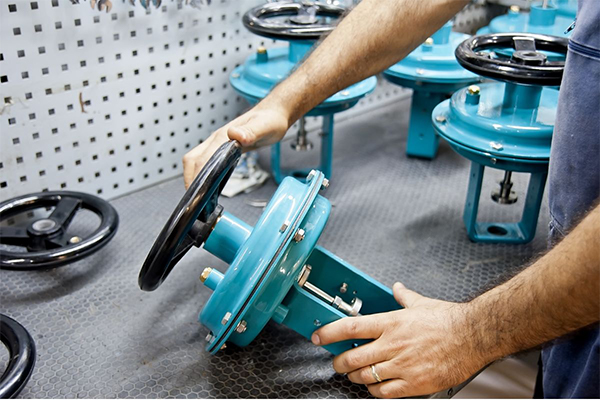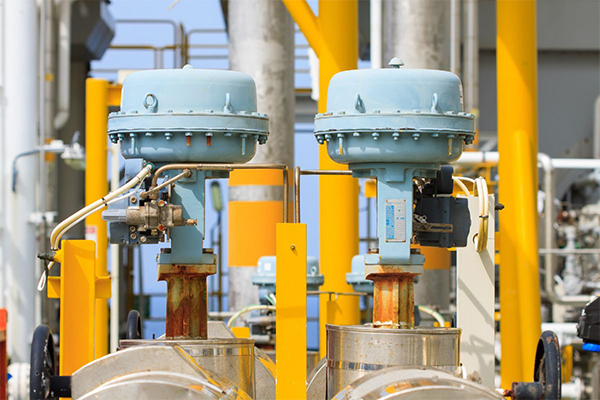- Gate valve
-
- DN1000 Extension stem double flange soft seal gate valveDIN F4 resilient seated gate valveDN450-1200 Resilient Seated Gate ValveDIN F5 resilient seated gate valveSocket connection soft seal gate valveUnderground cap soft seal gate valveBS5163 rising stem soft seal gate valveHard seal gate valveAPI slab Gate ValveStainless steel flange gate valveWafer knife gate valvePneumatic gate valveSoft seal gate valveExtension stem gate valveUL/FM fire protection groove ends gate valveRising stem forged steel gate valvecarbon steel gate valveStainless steel threaded gate valveDIN soft seal gate valveANSI soft sealing gate valve 200PSICast iron gate valveBS resilient seated gate valve
- Butterfly valve
-
- DN900 pneumatic triple eccentric hard seal butterfly valveD643H Triple Eccentric Butterfly ValveD343H Hard seal butterfly valveMulti standard EPDM seated butterfly valveSingle flange butterfly valveDN2000 Double eccentric butterfly valveFlange butterfly valveLug butterfly valveWafer butterfly valve with handleWorm gear operated butterfly valveWafer lined fluorine butterfly valveStainless steel wafer butterfly valveStainless steel flanged butterfly valveThree eccentric flange butterfly valvePneumatic flanged butterfly valvePneumatic wafer butterfly valveTriple eccentric butterfly valve wafer typeWafer butterfly valve ULC approvedInflatable seat butterfly valveHigh performance butterfly valveGrooved end butterfly valveElectric soft seal butterfly valveFlange fluorine lined butterfly valveHandle aluminum butterfly valveWorm Gear Aluminum Butterfly ValveFull PTFE lined butterfly valve wafer typeOne stem no-pin wafer butterfly valveMulti standard aluminum stem butterfly valveStainless Steel wafer Butterfly ValveAluminium handle operated lug butterfly valveLever Operated Flange Butterfly ValveButterfly valve stemButterfly valve discButterfly valve seat
- Ball valve
-
- DN1400 top-mounted eccentric semi-ball valveFlanged three-way ball valveFully welded ball valveNatural gas ball valveHigh platform flange ball valve1 PC ball valveFixed ball valvePTFE seat flanged ball valveMetal seat ball valveAPI 6D ball valve3 Piece ball valveFull Bore 3 way ball valve L-Port3 Way T-Port ball valve2PC Ball valve female thread stainless steel
- Globe Valve
-
- API Carbon Steel Globe ValveBellows Globe ValveStainless steel flange globe valveStainless steel thread S type globe valveStainless steel thread B type globe valveCast Steel Globe ValvePiston Globe ValveWCB Carbon Steel Globe Check Valveelectric motorized control stainless steel SS316 globe valveBrass Globe ValveCryogenic Globe valveHT200 Globe ValveThreaded Stainless Steel Globe ValveGG25 Globe ValveANSI API Cast Steel And Stainless Steel Globe valve
- Check valve
-
- Rubber seal check valveDN800 Slow closing check valveDN800 Rubber Disc Check ValveButterfly Buffering Check Valvecheck valve with counter weightSilent Check ValveWCB Swing check valveSwing Check ValveSingle Chip Check Valve H74WStainless Steel Wafer Check ValveSwing Start Check ValveFoot check valveAPI Swing Check ValveDIN Flange check valveSingle plate check valveLifting Check ValveBottom ValveHammer Diminish Noises Check ValveWafer Check ValveWafer dual plate check valve
- Control valve
-
- Static Balancing ValveCage Guided Sleeve Globe Control ValveDN1000 Piston Flow Regulating ValveDN1600 Electric Actuator Flow Regulating ValvePneumatic Flanged Butterfly ValvePneumatic Wafer Butterfly ValveAngle Seat ValvePneumatic gate valveElectric three-way control valveElectric sleeve control valve
- Water Meter
-
- Vertical Type Water MetersStainless steel threaded water meterPiston water meterPlastic water meterMore flow rotor dry water meterspiral vane flange water meterCI wotlman water meter with pulse outputLXCLG(R) Vertical removable element woltman cold (hot) water meterSingle flow rotor dry water meterPrepaid Token Water MeterElectromagnetic flowmeterRotary Piston Liquid Sealed Water MeterRotary Piston Liquid Sealed Water Meter
- Air valve
-
- Double ball exhaust valveDoubleair Air Valve SaudiDoubleair Air Valve Southeast AsiaDoubleair Air Valve South AmericaDouble Air ValveThreaded Air ValveSingle Air ValveTriple Functions Air ValveAutomatic Air Release ValveAutomatic release valveAutomatic exhaust valveComposite Exhaust Air ValveBrass exhaust valveDouble Ball Air Valve
- Pipe Repair & Coupling
-
- Flexible Multi-Function Pipe Coupling ZFJ-SSS Semi-Circle Pipe Repair Clamp SJW-HDuctile Iron Band Repair ClampStainless Steel Band Repair ClampDouble-Section Pipe Repair CouplingFolding Type Pipe RepairSingle-Section Multi-Function Pipe Coupling MF-SGear-Ring Type Multi-Function Pipe Coupling GR-SZBW Damping Corrugated Hose
- Dismantling Joint
-
- VSSJAFC(CC2F) Detachable Flange Transmission JointVSSJA-2(B2F) Double Flange Limited Expansion JointVSSJA-1(BF) Single Flange Limited Expansion JointVSSJA(AF) Flange Loose Expansion JointJGD-B Threaded Rubber JointZBW Damping Corrugated HoseKXT-S Flexible Dual-Spherical Rubber JointKXT Rubber Soft JointFlange Adaptor
Installation and maintenance of control valve
Installation, maintenance and common faults of regulating valve
In the automation of coal chemical production process, regulating valve plays an important role in stabilizing production, optimizing control and maintenance. As the terminal execution device of the automatic adjustment system, the regulating valve accepts the control signal to realize the adjustment of the chemical process, which is directly related to the normal production of the whole device. To do this work well, it is necessary not only to fully understand its various characteristics in theory, but also to comprehensively analyze and judge in combination with actual use experience, so as to give full play to the role of the regulating valve.
1. Installation of regulating valve
The installation quality of the regulating valve directly affects the operating performance, safety, and cost of the regulating valve, ensuring that it plays a good control role in the control system. During installation, pay attention to the following issues:
1) The inspection before the installation of the regulating valve is a very important link to confirm whether the regulating valve meets the design requirements. The specifications and models of the regulating valve include: valve model, valve type, nominal diameter, valve seat size, valve core form, flow characteristics, leakage grade, valve body material, valve core material, valve seat material, CV value, flange standard grade Size and sealing surface form, etc.
2) Before installing the regulating valve, the dust accumulated during the storage of the valve must be carefully removed, because the dust and impurities will damage the valve seat and internal parts, usually a cover plate is installed at the end of the open flange or a plastic wrap is used to seal it.
3) The regulating valve should be installed vertically on the horizontal pipeline. If it must be installed inclined or horizontally, the support should be added. There should be straight pipes longer than 10 times the pipe diameter before and after the valve.
4) The flow direction of the fluid should be the same as the mark on the valve body.
5) The installation of the regulating valve is often disturbed by the vibration source, which will directly affect the performance of the regulating valve. Therefore, try to avoid installing in places with vibration sources.
6) The quality of the installation position of the regulating valve directly affects the level of maintenance costs, so the regulating valve should be installed in a position that is convenient for maintenance and repair.
7) In order to stabilize the air source and protect the instrument, the regulating valve is often installed and used together with the air filter pressure reducer and safety valve.
8) After installation, when the pipeline is pressure tested and blown off, the regulating valve should be removed and connected with the corresponding straight pipe section to prevent debris such as welding slag and iron chips from being stuck between the valve core and the valve seat. The end of the opening flange of the dismantled regulating valve should be firmly wrapped with plastic cloth.
2. Routine maintenance and common faults of regulating valve
2.1. Daily maintenance of regulating valve
The maintenance of the regulating valve is often overlooked by people. Due to improper maintenance, accidents that cause the entire control system to fail frequently occur. The regulating valve is a very important and indispensable part of the automatic control system. If the regulator is compared to the human brain, then the regulating valve is the hands and feet of the human being. We must pay attention to its maintenance work to ensure the normal operation of the regulating system. , reliable and efficient operation. The daily maintenance of the regulating valve is divided into two parts: patrol inspection and regular maintenance.
The contents of the patrol inspection are as follows: 1. Check the operation of the regulating valve from the process operator on duty; 2. Check whether the air supply pressure of the regulating valve or the positioner and the purification of the air source are normal; 3. Check whether the static and dynamic sealing points of the regulating valve are there or not. Leakage; ④ Check whether the connection part of the regulating valve is loose, whether the joint is loose, leaking or corroded; ⑤ Check whether the instrument operates within the prescribed stroke, and check whether the handwheel mechanism is placed in the "release" position; ⑥ Observe when the regulating valve is in the manual position Check whether the regulating valve stem still moves up and down; ⑦ Check whether the action of the regulating valve is flexible and whether it changes in time when the control signal changes; ⑧ Check the rain and corrosion protection of the actuator and regulating valve to avoid damage to the actuator due to water ingress and other reasons ; ⑨ Contact and deal with problems in time; ⑩ Make records of patrol inspections and file them.
The contents of regular maintenance work are as follows: ① Regularly clean the outside of the control valve; ② Regularly adjust the control valve stuffing box and other sealing components, and replace the sealing components if necessary to maintain the sealing of static and dynamic sealing points; ③ Regularly Check the wheel parts to keep the handwheel flexible and easy to use; ④ Regularly check the diaphragm, piston, spring, seal and other key components, and carry out anti-corrosion, lubrication or replacement; ⑤ Regularly add lubricating oil to the parts that need to be lubricated; Source or hydraulic filter system for sewage and cleaning work; ⑦ Regularly check the connection and corrosion of each connection point, and replace the connection parts if necessary.
www.hawsd.com/products/control-valve/
2.2. Common faults of regulating valve
The regulating valve is an important link in the automatic control system, and it is the control mechanism that directly contacts the process medium, and is subjected to the pressure, temperature, erosion, corrosion and wear of the fluid, and the accessories of the regulating valve are easily affected by the surrounding environment. The common faults of the regulating valve are:
2.2.1. Air source system failure
1) The instrument air line is blocked. Since the ball valve has a throttling effect at the end of the air line of the instrument branch, the dirt in the air line is easy to accumulate and block here. If the air pressure of the instrument is too low, the regulating valve cannot be fully opened and fully closed, or even the regulating valve does not act.
2) The air filter pressure reducing valve is faulty. The air filter pressure reducing valve has too much dirt when used for a long time, the pressure reducing valve leaks air, and the set output pressure of the pressure reducing valve is too low, so that the output instrument wind pressure is less than the specified pressure, so that the regulating valve moves slowly and cannot be fully opened or closed. Not even moving.
3) Copper pipe connection failure. The copper pipe is aging and leaking, the joint connection is loose or the dirt blocks the copper pipe, so that the air pressure of the instrument signal is low, so that the regulating valve does not move and cannot be fully opened or closed.
2.2.2. Power system failure
1) The terminals of the power cord are loose and short-circuited. Due to the on-site vibration, the loose wiring or too much dust caused the wiring to be loose due to the on-site vibration, so that the signal from the control room to the site is sometimes absent, resulting in the chaotic operation of the regulating valve and the regulation oscillation. The equipment is short-circuited due to water or damp or other reasons, so that the control valve cannot be fully opened and closed.
2) The middle connector of the power cord or the damaged part in the middle is faulty. The power cord is subject to environmental vibration, external force pulling, the failure of insulating tape, the decline of insulation performance, and the high temperature baking of the connector, which makes the power cord connector loose or seems to be broken, short circuit between power lines or short circuit to ground, and the terminal or the power cord is broken. As a result, the action of the regulating valve is discontinuous, and it cannot be fully opened, fully closed or even not moved.
3. Valve positioner failure
3.1. Mechanical electrical valve positioner
1) The zero point and range are inaccurate. Due to inaccurate debugging during the installation of the positioner or on-site vibration, temperature changes, changes in the stroke of the control valve stem, changes in the position of the feedback rod, etc., the minimum and maximum openings of the control valve are inconsistent with the signal in the control room. As a result, the signal output by the valve positioner cannot make the control valve fully open and fully close, resulting in large leakage and limited quantities. In the on-site adjustment of the positioner, first ensure that the regulating valve operates well, the feedback system is firmly installed and operates well, and then adjusts through the standard signal. Make the stroke of the regulating valve consistent with the control signal.
2) The orifice is blocked. Because the instrument air is not clean, the dirt blocks the orifice, so that the positioner has no output signal, resulting in the control valve not moving.
3) There is dirt between the nozzle and baffle. Affected by the on-site environment, a layer of dust will adhere to the positioner after a period of use, which will affect the back pressure of the nozzle baffle, thereby affecting the output of the positioner. The state of the regulating valve is unstable, resulting in vibration.
4) The sealing is not good. Various fastening nuts and sealing gaskets of the positioner used for a long time are prone to loosening and aging, resulting in air leakage of the positioner, so that the regulating valve cannot be fully opened and closed, and the valve position is unstable, resulting in adjustment oscillation.
5) The feedback lever is faulty. During long-term operation, the tightening nut of the feedback rod gradually loosens or even falls off, which causes the feedback rod to become loose, skewed, collide with the fixing parts, and fall off, which makes the control valve move slowly, fluctuate frequently, and the control valve is limited or even out of control. The limit spring on the feedback board falls off, or the feedback rod comes out of it, resulting in poor contact between the feedback rod and the feedback board, resulting in a lag, resulting in frequent movements of the regulating valve, making it difficult to stabilize the controlled parameters, especially when the regulating valve action requires accurate temperature control have a greater impact.
6) The fixing nut is loose. If the fixing nut of the positioner is not installed firmly, it will be loose, which will cause the positioner to be skewed, which will affect the action of the feedback rod, resulting in the phenomenon of jamming; The tightening screws of various springs in the positioner are loosened under the vibration environment, which changes the preload of the spring and affects the tension and state of the spring; the zero-point range of the positioner is changed, and the positioner is not linear, so that the regulating valve cannot be fully When the switch is fully closed, the action of the regulating valve is not linear.
3.2. Smart Locator
1) The feedback lever is faulty. The tightening nut of the feedback rod is loose or even falls off, causing the feedback rod to be loose, skewed, stuck with the fixed parts, and falling off, making the control valve move slowly, fluctuate frequently, and the control valve is limited or even out of control. If the positioner is not fixed firmly, it will be skewed and loose, which will affect the movement of the feedback rod, resulting in the phenomenon of jamming and limiting the regulating valve. The limit spring on the feedback board falls off, or the feedback rod comes out of it, resulting in poor contact between the feedback rod and the feedback board, resulting in a lag, resulting in frequent movements of the regulating valve.
2) The electronic feedback device is faulty. When the electronic feedback device (or feedback potentiometer) runs repeatedly for a long time, or runs within a certain range for a long time, the linearity of the potentiometer becomes worse or fluctuates, which seriously affects the normal use of the positioner. After running for a period of time, try to check the potential The actuator operates linearly or over the full travel range for a period of time.
3) The control circuit is faulty. Due to the environmental temperature, humidity, sealing and other conditions of the positioner during operation, the electronic components of the control circuit are aged and deteriorated due to excessive temperature, low temperature, excessive humidity or corrosion, etc., which directly lead to the failure of the positioner and lead to production accidents.









